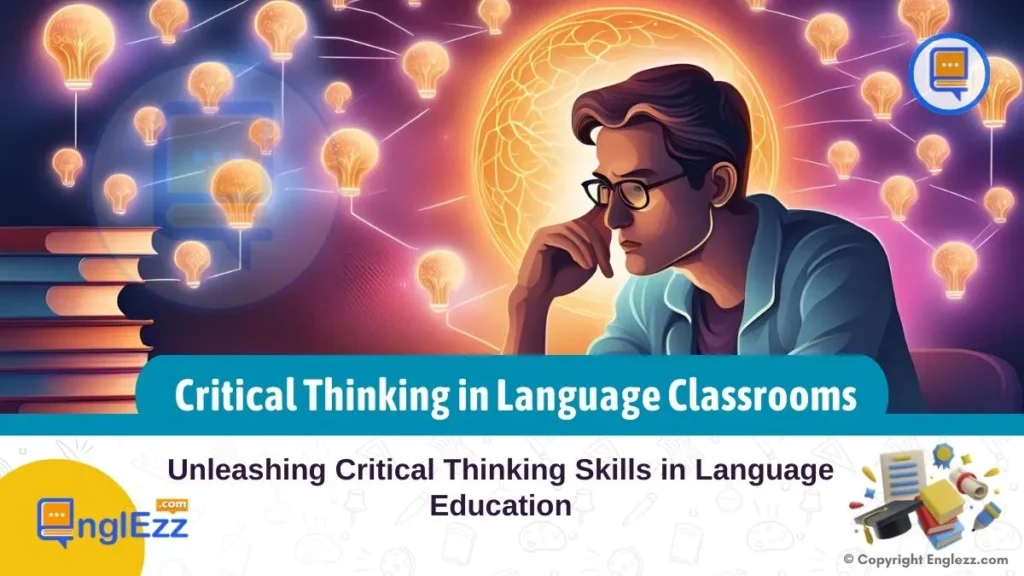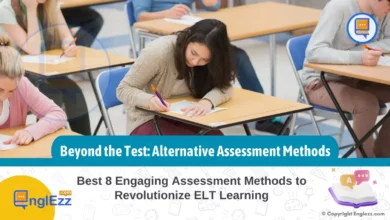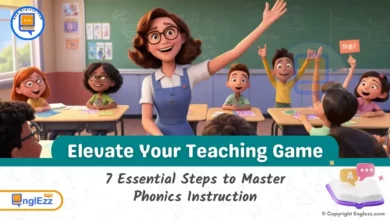In the realm of language education, where the acquisition of linguistic proficiency intertwines with the cultivation of critical thinking skills, the role of language educators and TESOL professionals emerges as paramount. The orchestration of these pedagogical forces not only nurtures students’ language competencies but also serves as a crucible for honing their analytical acumen.
Through a strategic integration of critical thinking into language lessons, educators pave a path that leads learners beyond mere syntax and semantics, unveiling the profound cognitive dimensions of language acquisition.
Table of Contents
- Unleashing the Power of Critical Thinking in Language Classrooms
- Critical Thinking Foundations in Language Education
- Thought-Provoking Exercises for Critical Thinking
- Integrating Real-World Dilemmas for Discussion
- Effective Strategies for Infusing Critical Thinking into Language Lessons
- Assessment Methods: Evaluating the Development of Critical Thinking Skills in Language Education
- Enhancing Language Education Through Critical Thinking Integration
- Frequently Asked Questions About Critical Thinking Skills in Language Education
- Q: Why is integrating critical thinking skills important in language education?
- Q How can educators design exercises that promote critical thinking in language classrooms?
- Q: What role do real-world dilemmas play in fostering critical thinking skills in language learners?
- Q: What strategies can be employed to assess students’ development of critical thinking skills in language education?
- Q: How does infusing technology tools enhance critical thinking experiences in language instruction?
Unleashing the Power of Critical Thinking in Language Classrooms
Within the intricate tapestry of language education lies a profound symbiosis between linguistic dexterity and cognitive prowess. By infusing critical thinking into the very fabric of language instruction, educators embark on a journey that transcends conventional paradigms of teaching and learning. This fusion not only enriches the educational landscape with intellectual vigor but also empowers students to navigate complexities with astute discernment.
As such, the marriage between language education and critical thinking illuminates pathways that equip learners with tools essential for both academic success and real-world application – beckoning towards a horizon where linguistic fluency intertwines seamlessly with analytical sagacity. Would you walk this path to unlock the synergies between words and wisdom?

The journey through the expanse of language classrooms unfolds not merely as a quest for grammar rules and vocabulary lists but as an odyssey toward intellectual enlightenment. As we delve deeper into the realms where linguistics interfaces with cognition, new vistas arise – inviting exploration into how unraveling thought processes alongside linguistic structures can revolutionize pedagogical landscapes.
Join us as we embark on an expedition to unleash critical thinking within language classrooms, empowering learners to decipher languages not just as mediums of communication but as gateways to profound insights and transformative knowledge. Walk with us through this scholarly discourse where letters dance in tandem with lucid logic, nurturing minds enriched by the harmonious symphony of words weaving together narratives laced with critical contemplation.
Critical Thinking Foundations in Language Education
Critical thinking serves as a fundamental skill set in language education due to its role in enhancing students’ ability to comprehend and solve complex problems within linguistic contexts. By encouraging critical thought, educators can cultivate students’ deeper understanding of language nuances, cultural implications, and communicative strategies.
- For example, when learners engage critically with literary texts or authentic materials in a second language, they develop analytical skills that allow them to interpret subtleties beyond surface meanings.
This process not only enriches their grasp of the language but also broadens their appreciation for diverse perspectives embedded in oral and written discourse.
Research consistently demonstrates a strong correlation between the development of critical thinking skills and improvements in language proficiency among learners. Studies have shown that students who are encouraged to think critically about language structures, evaluate arguments effectively, and construct coherent narratives exhibit higher levels of linguistic competence. For instance, by analyzing persuasive writing or engaging in debate exercises, students not only refine their argumentation skills but also expand their vocabulary usage and grammatical accuracy through active engagement with authentic language tasks.
Encouraging divergent thinking involves prompting students to explore multiple solutions or perspectives when tackling language-related problems. For instance, when analyzing a complex text in a foreign language, encourage students to consider various interpretations beyond the literal meaning of the words. By fostering divergent thinking, learners develop creativity and resourcefulness in approaching language tasks.
In practice, educators can implement various pedagogical approaches that intertwine critical thinking with linguistic competencies to optimize student learning outcomes. By incorporating structured activities that require problem-solving skills alongside language practice, instructors can create dynamic learning environments that foster cognitive growth.
- For instance, tasks that prompt students to identify logical fallacies within a spoken dialogue contribute not only to their critical thinking abilities but also to their phonological awareness and listening comprehension skills.
Therefore, integrating critical thinking into language education serves as a multifaceted strategy to deepen students’ linguistic proficiency while nurturing their capacity for analytical reasoning and effective communication.
Thought-Provoking Exercises for Critical Thinking
In language education, thought-provoking exercises serve as catalysts for developing critical thinking skills, allowing students to delve deep into linguistic contexts while honing their analytical abilities. By designing exercises that prompt students to analyze, evaluate, and synthesize information in the target language, educators foster a mindset of inquiry and reflection. For instance, asking students to critically assess arguments presented in a text or debate differing viewpoints on a language-related topic compels them to engage with material beyond surface comprehension.

To stimulate critical thought further, incorporating activities like inferential reasoning tasks can aid learners in connecting context clues within language structures to derive meaning effectively. For example, providing students with passages containing implicit information necessitates them to make logical inferences based on textual evidence. Similarly, engaging students in logical deduction exercises challenges them to apply deductive reasoning principles to decipher patterns or draw conclusions systematically within a linguistic framework.
Moreover, fostering collaborative critical thinking through group discussions or problem-solving scenarios cultivates the skill of evaluating diverse perspectives collectively. By engaging in debates where students defend their stances backed by rationale or collaborating on complex language-related puzzles, learners not only sharpen their critical thinking prowess but also enhance their ability to communicate persuasively and respectfully within a collaborative setting.
Through these exercises, educators can empower students with the tools needed to navigate linguistic complexities while honing their cognitive agility through applied critical thinking practices.
Integrating Real-World Dilemmas for Discussion
In language classrooms, integrating real-world dilemmas offers a powerful avenue for honing students’ critical thinking skills. By immersing learners in authentic materials that present complex scenarios or societal issues, educators create opportunities for students to apply their analytical abilities to practical situations.
- For instance, presenting a dilemma where characters in a story must make decisions involving cultural nuances or moral values can prompt students to navigate through various perspectives and consequences, fostering a deeper engagement with the material.
This approach not only enhances language comprehension but also nurtures essential critical thinking competencies. Encouraging students to explore multiple viewpoints and ethical considerations within real-world dilemmas cultivates their ability to think critically beyond surface-level analysis. For example, discussing a controversial current event article in the target language can stimulate debates among students, compelling them to evaluate different opinions, biases, and underlying motivations portrayed in the text.
By unpacking these complexities collaboratively, learners develop a richer understanding of how linguistic choices reflect diverse worldviews and shape discourse conventions. Such exercises encourage cognitive flexibility and empathy while sharpening students’ capacity for nuanced reasoning.
Facilitating reflective discussions following real-world dilemma exploration prompts students to articulate reasoned arguments effectively. After engaging with authentic materials depicting challenging situations, educators can guide learners in synthesizing their thoughts through structured conversations aimed at justifying viewpoints logically and coherently.
Encouraging students to express their insights, draw connections between language use and societal implications, and defend their interpretations fosters not only language proficiency but also sharpens critical thinking skills vital for navigating multifaceted contexts effectively. This approach deepens student engagement, encourages intellectual growth, and prepares learners for applying critical thought processes beyond the classroom setting.
Effective Strategies for Infusing Critical Thinking into Language Lessons
Incorporating critical thinking elements into language lessons necessitates a strategic approach to cultivate students’ analytical skills alongside linguistic proficiency. By integrating activities that transcend rote memorization, educators can promote deeper cognitive engagement among learners. For instance, designing tasks where students critically analyze authentic texts or multimedia content in the target language prompts them to go beyond surface-level comprehension and delve into nuanced interpretations. This shift towards higher-order thinking not only enhances language acquisition but also nurtures essential skills for academic and professional success.
It is essential to cultivate metacognitive awareness among language learners by encouraging them to reflect on their thinking processes. Teachers can prompt students to articulate how they approached a particular language task, what strategies they employed, and how effective those strategies were in achieving the desired outcome. This reflection enhances students’ self-regulation skills and empowers them to monitor and optimize their own learning journey.
Scaffolding tasks progressively is another vital strategy in fostering students’ critical thinking abilities within language classrooms. Beginning with simpler exercises that emphasize identifying key points within a text can gradually advance to more complex tasks requiring students to evaluate arguments, recognize biases, and synthesize information effectively. This incremental approach supports students in developing the necessary skills to engage critically with varied discourse types, thereby empowering them to navigate diverse linguistic contexts with confidence and acumen.
Moreover, leveraging technology tools and multimedia resources presents endless possibilities for enhancing critical thinking experiences in language education. For example, utilizing interactive online platforms where students collaborate on analyzing multimedia content or engaging in virtual debates sharpens their ability to think critically while leveraging digital literacy skills.
By creatively integrating technology into language instruction, educators can offer dynamic learning environments that not only foster linguistic competence but also instill the capacity for agile problem-solving and reasoned decision-making—valuable assets in today’s interconnected world.
Assessment Methods: Evaluating the Development of Critical Thinking Skills in Language Education
In assessing students’ critical thinking skills development within language education, it is crucial to establish clear assessment criteria that align with specific dimensions of critical thinking. Tailoring assessment measures to the desired language learning outcomes helps educators gauge students’ progress accurately.
- For instance, creating rubrics that delineate the components of critical thinking—such as evaluating arguments, problem-solving strategies, and evidence interpretation—can provide a comprehensive framework for assessment.
By defining these criteria explicitly, instructors can offer constructive feedback that highlights areas for improvement and recognizes strengths.
Implementing Socratic questioning techniques can deepen students’ critical thinking skills by stimulating dialogue and inquiry. Through thought-provoking questions that challenge assumptions, encourage clarity, and prompt reasoned arguments, educators can guide students towards developing more analytical approaches to language analysis and problem-solving. By integrating Socratic questioning into language lessons, teachers promote active engagement with content while honing students’ analytical prowess.
One effective approach to evaluating critical thinking skills in language classrooms involves formulating authentic assessment tasks that integrate higher-order cognitive skills with linguistic competencies. For example, designing a task where students analyze a complex text in the target language requires them not only to comprehend the content but also to critically evaluate its implications, identify underlying assumptions, and draw reasoned conclusions. By intertwining critical thinking demands with language tasks, educators can assess students’ ability to apply analytical skills within the linguistic context effectively.
Moreover, providing constructive feedback is instrumental in guiding students towards advancing their critical thinking abilities while honing their language proficiency simultaneously. Feedback should be targeted at specific aspects of critical thinking performance, offering actionable insights for improvement.
By highlighting areas where students demonstrate strong critical reasoning and areas needing development, educators assist learners in understanding how to enhance their analytical skills alongside their language mastery. Constructive feedback becomes a roadmap for students to refine their critical thinking competencies systematically throughout their language learning journey.
Enhancing Language Education Through Critical Thinking Integration
Incorporating critical thinking skills development into language education not only enhances students’ linguistic proficiency but also equips them with indispensable cognitive tools that are transferable across disciplines. By infusing tasks that require analysis, evaluation, and synthesis of information, educators can cultivate students’ capacity for deeper comprehension and problem-solving. For example, designing exercises where learners critically assess conflicting opinions in a debate strengthens their ability to weigh evidence and construct well-supported arguments, fostering a more nuanced approach to language use.
Engaging students with real-world dilemmas within the language classroom provides an authentic context for applying critical thinking skills. For instance, presenting culturally relevant scenarios or ethical quandaries challenges students to consider diverse perspectives and navigate complex linguistic nuances effectively. By encouraging reflective discussions that prompt students to articulate reasoned viewpoints, educators foster a learning environment where critical inquiry is valued alongside linguistic accuracy.

By integrating effective pedagogical strategies that seamlessly blend critical thinking elements with language learning objectives, educators create dynamic lesson plans that transcend rote memorization and encourage active intellectual engagement. Scaffolding tasks progressively to help students dissect complex texts, identify underlying assumptions, and draw informed conclusions builds a foundation for robust critical thinking abilities within the realm of language education.
Additionally, leveraging technology resources thoughtfully can enrich students’ critical thinking experiences by providing interactive platforms for analyzing multimedia content or engaging in collaborative problem-solving tasks.
Frequently Asked Questions About Critical Thinking Skills in Language Education
Q: Why is integrating critical thinking skills important in language education?
A:** Integrating critical thinking skills in language education enhances students’ ability to comprehend texts deeply, solve problems creatively, and engage critically with linguistic content, thereby equipping them for success in various communication contexts.
Q How can educators design exercises that promote critical thinking in language classrooms?
**A:** Educators can design exercises that challenge students through activities like inferential reasoning tasks, argument analysis, logical deduction exercises, group discussions, debates, or problem-solving scenarios tailored to stimulate critical thought.
Q: What role do real-world dilemmas play in fostering critical thinking skills in language learners?
A: Real-world dilemmas serve as authentic materials that engage students in applying critical thinking skills practically by exploring multiple perspectives related to language issues and facilitating reflective discussions on ethical considerations.
Q: What strategies can be employed to assess students’ development of critical thinking skills in language education?
A: Educators can develop assessment criteria aligned with specific dimensions of critical thinking integrated with linguistic tasks. Using authentic assessment tasks that evaluate problem-solving abilities and creative reasoning provides valuable insights into students’ progress.
Q: How does infusing technology tools enhance critical thinking experiences in language instruction?
A: Leveraging technology tools creatively within language lessons enriches critical thinking experiences by offering interactive platforms for analyzing complex texts and developing higher-order cognitive skills alongside traditional linguistic competencies.
By incorporating these tips into language pedagogy, educators can unleash the transformative power of critical thinking in language classrooms, empowering students to navigate linguistic challenges with confidence and intellectual agility while fostering a deeper understanding of languages and cultures.









Power of critical thinking in language classrooms leads to transformative learning! Uncover methods to inspire creativity and critical analysis among students.